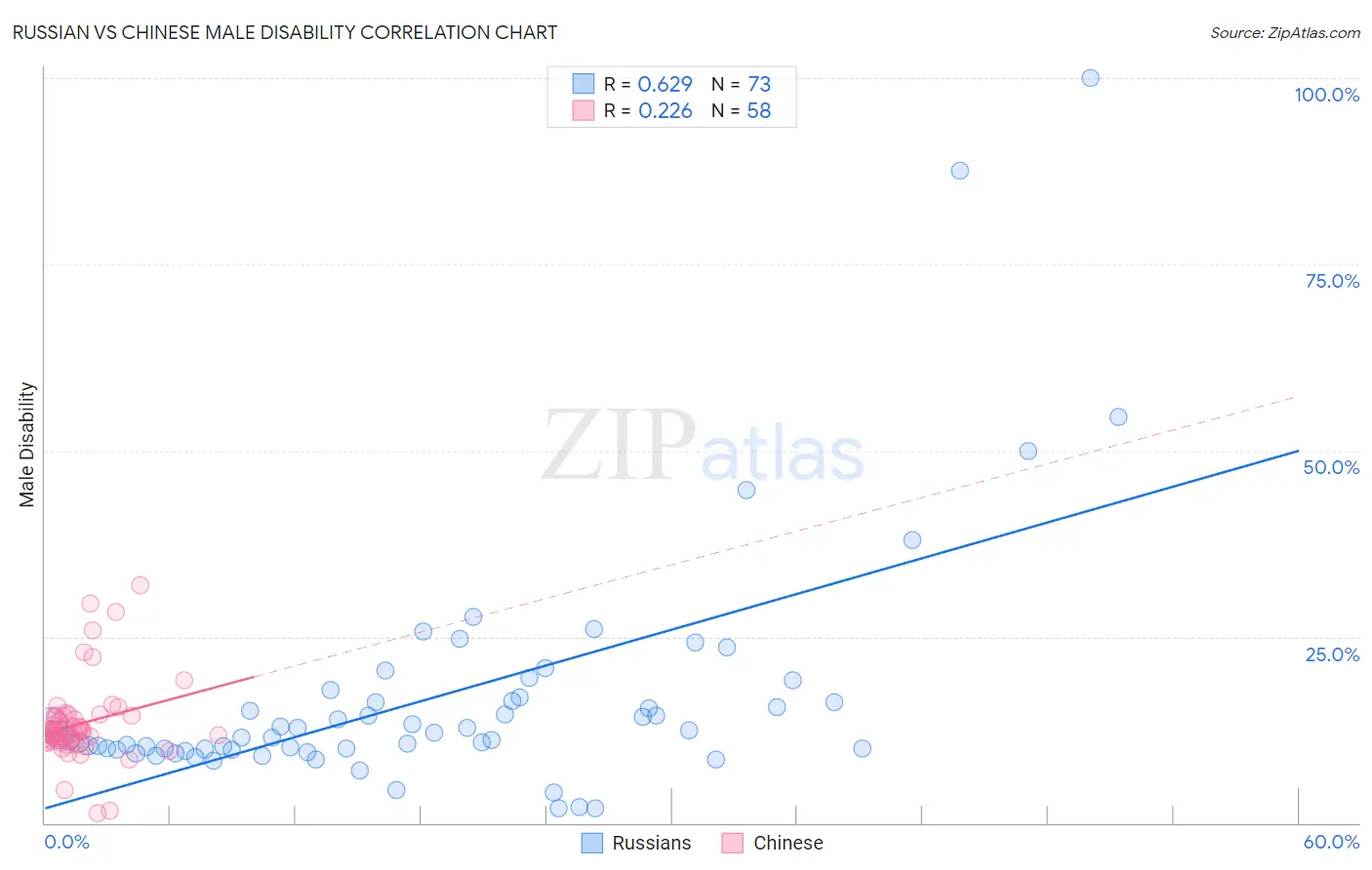Russian vs Chinese Male Disability
COMPARE
Russian
Chinese
Male Disability
Male Disability Comparison
Russians
Chinese
11.1%
MALE DISABILITY
69.8/ 100
METRIC RATING
156th/ 347
METRIC RANK
12.1%
MALE DISABILITY
0.4/ 100
METRIC RATING
255th/ 347
METRIC RANK
Russian vs Chinese Male Disability Correlation Chart
The statistical analysis conducted on geographies consisting of 512,092,434 people shows a significant positive correlation between the proportion of Russians and percentage of males with a disability in the United States with a correlation coefficient (R) of 0.629 and weighted average of 11.1%. Similarly, the statistical analysis conducted on geographies consisting of 64,802,721 people shows a weak positive correlation between the proportion of Chinese and percentage of males with a disability in the United States with a correlation coefficient (R) of 0.226 and weighted average of 12.1%, a difference of 8.8%.

Male Disability Correlation Summary
| Measurement | Russian | Chinese |
| Minimum | 2.0% | 1.3% |
| Maximum | 100.0% | 31.9% |
| Range | 98.0% | 30.7% |
| Mean | 16.8% | 13.4% |
| Median | 11.8% | 12.4% |
| Interquartile 25% (IQ1) | 9.9% | 11.1% |
| Interquartile 75% (IQ3) | 16.7% | 14.4% |
| Interquartile Range (IQR) | 6.8% | 3.3% |
| Standard Deviation (Sample) | 16.2% | 5.6% |
| Standard Deviation (Population) | 16.1% | 5.5% |
Similar Demographics by Male Disability
Demographics Similar to Russians by Male Disability
In terms of male disability, the demographic groups most similar to Russians are Immigrants from Western Africa (11.1%, a difference of 0.040%), Immigrants from Middle Africa (11.1%, a difference of 0.070%), Latvian (11.1%, a difference of 0.11%), Guatemalan (11.1%, a difference of 0.17%), and Immigrants from Moldova (11.1%, a difference of 0.21%).
| Demographics | Rating | Rank | Male Disability |
| Immigrants | Denmark | 76.4 /100 | #149 | Good 11.0% |
| Immigrants | Guatemala | 75.1 /100 | #150 | Good 11.0% |
| Cubans | 74.9 /100 | #151 | Good 11.0% |
| Immigrants | Albania | 74.4 /100 | #152 | Good 11.0% |
| Immigrants | Northern Europe | 73.2 /100 | #153 | Good 11.1% |
| Immigrants | Moldova | 72.8 /100 | #154 | Good 11.1% |
| Immigrants | Middle Africa | 70.9 /100 | #155 | Good 11.1% |
| Russians | 69.8 /100 | #156 | Good 11.1% |
| Immigrants | Western Africa | 69.2 /100 | #157 | Good 11.1% |
| Latvians | 68.1 /100 | #158 | Good 11.1% |
| Guatemalans | 67.2 /100 | #159 | Good 11.1% |
| Albanians | 66.5 /100 | #160 | Good 11.1% |
| Immigrants | West Indies | 65.7 /100 | #161 | Good 11.1% |
| Immigrants | Haiti | 65.3 /100 | #162 | Good 11.1% |
| Immigrants | Kenya | 63.8 /100 | #163 | Good 11.1% |
Demographics Similar to Chinese by Male Disability
In terms of male disability, the demographic groups most similar to Chinese are British (12.1%, a difference of 0.010%), Slovene (12.0%, a difference of 0.20%), Guamanian/Chamorro (12.0%, a difference of 0.20%), Swiss (12.1%, a difference of 0.25%), and European (12.1%, a difference of 0.25%).
| Demographics | Rating | Rank | Male Disability |
| Poles | 0.7 /100 | #248 | Tragic 12.0% |
| Immigrants | Yemen | 0.5 /100 | #249 | Tragic 12.0% |
| Bangladeshis | 0.5 /100 | #250 | Tragic 12.0% |
| German Russians | 0.5 /100 | #251 | Tragic 12.0% |
| Slovenes | 0.5 /100 | #252 | Tragic 12.0% |
| Guamanians/Chamorros | 0.5 /100 | #253 | Tragic 12.0% |
| British | 0.4 /100 | #254 | Tragic 12.1% |
| Chinese | 0.4 /100 | #255 | Tragic 12.1% |
| Swiss | 0.3 /100 | #256 | Tragic 12.1% |
| Europeans | 0.3 /100 | #257 | Tragic 12.1% |
| Basques | 0.3 /100 | #258 | Tragic 12.1% |
| Belgians | 0.3 /100 | #259 | Tragic 12.1% |
| Swedes | 0.3 /100 | #260 | Tragic 12.1% |
| Slavs | 0.2 /100 | #261 | Tragic 12.2% |
| Norwegians | 0.2 /100 | #262 | Tragic 12.2% |